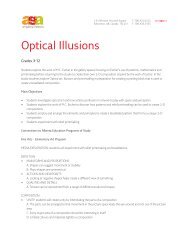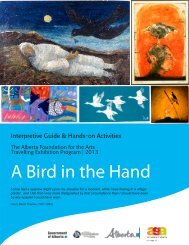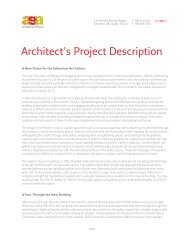Down on the Farm - Art Gallery of Alberta
Down on the Farm - Art Gallery of Alberta
Down on the Farm - Art Gallery of Alberta
- No tags were found...
You also want an ePaper? Increase the reach of your titles
YUMPU automatically turns print PDFs into web optimized ePapers that Google loves.
The <strong>Alberta</strong> Foundati<strong>on</strong> for <strong>the</strong> <strong>Art</strong>s Travelling Exhibiti<strong>on</strong> ProgramAgriculture in <strong>Alberta</strong> c<strong>on</strong>tinuedPhysical Geography and ClimatePhysiography, climate, soil and vegetati<strong>on</strong> combine to delineate four biophysical regi<strong>on</strong>s within<strong>Alberta</strong>. The prairie regi<strong>on</strong> includes most <strong>of</strong> sou<strong>the</strong>rn <strong>Alberta</strong>, more precisely <strong>the</strong> land south andeast <strong>of</strong> an arc stretching from Watert<strong>on</strong> in <strong>the</strong> southwest corner to a point al<strong>on</strong>g <strong>the</strong>Saskatchewan border east <strong>of</strong> Red Deer. This rolling grassland is relatively dry and mostlytreeless.The parkland regi<strong>on</strong> predominates in central <strong>Alberta</strong>, forming a crescent to <strong>the</strong> west and north<strong>of</strong> <strong>the</strong> prairie regi<strong>on</strong> and including most <strong>of</strong> <strong>the</strong> North Saskatchewan River drainage basin. Thisarea varies from <strong>the</strong> flatland <strong>of</strong> old lake bottoms to rolling landscape with numerous lakes anddepressi<strong>on</strong>s. It c<strong>on</strong>tains both treed and grassy terrain, with soil and climatic factors favourable toagriculture.The Boreal Forest regi<strong>on</strong> covers <strong>the</strong> nor<strong>the</strong>rn half <strong>of</strong> <strong>the</strong> province. Here great rivers and lakesdominate <strong>the</strong> landscape, draining northward to <strong>the</strong> Arctic Ocean. Soil and climatic factorsdo not favor agriculture, except in <strong>the</strong> Peace River regi<strong>on</strong> <strong>of</strong> <strong>the</strong> northwest where parklandc<strong>on</strong>diti<strong>on</strong>s create <strong>the</strong> world’s most nor<strong>the</strong>rly grain-growing area.The prairie regi<strong>on</strong> <strong>of</strong> sou<strong>the</strong>rn <strong>Alberta</strong> includes both short-grass and mixed-grasscharacteristics. The short-grass area <strong>of</strong> <strong>the</strong> sou<strong>the</strong>astern corner features short, drought-resistantgrasses such as blue grama, growing <strong>on</strong> light brown soil deficient in nitrogen and phosphorus,and about 12 cm deep. Annual water deficiency and wind erosi<strong>on</strong> cause c<strong>on</strong>siderable soildrifting. The mixed-grass area, forming an arc to <strong>the</strong> west and north <strong>of</strong> <strong>the</strong> short-grass regi<strong>on</strong>,c<strong>on</strong>tains more fertile, dark brown soil, while western wheat grass and o<strong>the</strong>r taller grassesprovide <strong>the</strong> natural vegetati<strong>on</strong>. The parkland regi<strong>on</strong> <strong>of</strong> central <strong>Alberta</strong> and <strong>the</strong> Peace Rivercountry are characterized by a natural vegetati<strong>on</strong> cover <strong>of</strong> tall grasses and aspen trees. Thecentral parkland c<strong>on</strong>tains fertile black soils, while <strong>the</strong> dark grey and grey soils <strong>of</strong> <strong>the</strong> PeaceRiver area are slightly less fertile. The province possesses an estimated 2,661 milli<strong>on</strong> ha <strong>of</strong> landsuitable for agriculture.Low annual precipitati<strong>on</strong>, high evaporati<strong>on</strong> rates and fast run<strong>of</strong>f produce chr<strong>on</strong>ic water deficits insou<strong>the</strong>rn <strong>Alberta</strong>, varying from a moderate deficiency in <strong>the</strong> parkland regi<strong>on</strong> to a severeshortage in <strong>the</strong> short-grass prairie area. Irrigati<strong>on</strong> has been used in <strong>the</strong> latter area since <strong>the</strong> late19th century, yet <strong>the</strong> amount <strong>of</strong> water available for irrigati<strong>on</strong> is itself limited by <strong>the</strong> water flow in<strong>the</strong> South Saskatchewan River basin.<strong>Alberta</strong>’s nor<strong>the</strong>rly latitude, stretching between latitude 49 degrees north and 60 degrees northputs <strong>the</strong> province in <strong>the</strong> nor<strong>the</strong>rn cool-temperate z<strong>on</strong>e. Thus cold winters and relatively short,cool summers are to be expected. The growing seas<strong>on</strong> lasts about 120 days in sou<strong>the</strong>rn<strong>Alberta</strong>, decreasing to 60 days in <strong>the</strong> north. In <strong>the</strong> north <strong>the</strong> shorter seas<strong>on</strong> is <strong>of</strong>fset by l<strong>on</strong>gerdays and lower altitudes and wheat is grown as far north as <strong>the</strong> Peace River.AFA Travelling Exhibiti<strong>on</strong> Program, Edm<strong>on</strong>t<strong>on</strong>, AB. Ph: 780.428.3830 Fax: 780.421.0479youraga.ca
















